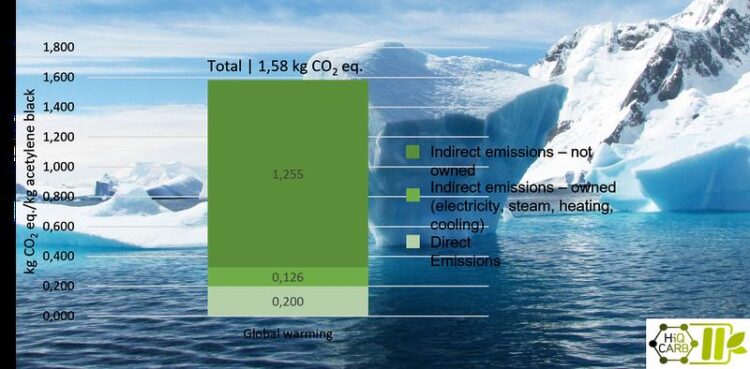Greener carbons for sustainable batteries

First results of the LCA study show a comparable low global warming impact of the HiQ-CARB acetylene black.
Credit: A. Mas-Fons, M.-L. Righi © HiQ-CARB project
– achievements after first half of the project work.
For the future decrease of carbon footprints in electromobility, the production of traction batteries has to become “greener”. In improving the electronic conductivity of battery cathodes carbon plays a critical role and thus is essential to achieve fast charging and discharging rates. The HiQ-CARB project, funded by EIT RawMaterials under the Horizon Europe Program started in 2021 to make the supply with high-quality conductive additives more sustainable, with low carbon footprint and resource-efficient carbon materials. The results after the first half of the project leave no doubt that a switch to more sustainable manufacturing methods is possible.
Large sectors of European industry, including the European automotive industry, are increasingly dependent on imported lithium-ion cells. According to increasing numbers of electric vehicles in use, the carbon footprint during fabrication gains momentum.
The HiQ-CARB approach for advanced and greener carbon additives is the combination of ultrathin carbon nanotubes and acetylene black beads thus receiving high conductivity and low CO₂ emissions during fabrication.
The HiQ-CARB project team reached out to achieve a sustainable set of objectives, fostering Europe as a location for the production of lithium-ion batteries and the production of advanced materials for lithium-ion-batteries. Validating strategic roadmaps and go-to-market strategies guaranteed a solid foundation for the further innovation management concerning the upscaling of acetylene black production up to 100 metric tons in the first project half and also the purification process for Arkema’s ultrathin carbon nanotubes. In parallel dedicated test specifications and procedures were established to qualify the materials for the use in battery cells.
Another challenge is to disperse acetylene black and carbon nanotubes homogeneously for the further processing. After first tests and improvements new formulations promise good processing properties.
Regarding the evaluation of the environmental impact of improved carbon formulations for the battery cell production, the HiQ-CARB project partners are pleased to share the initial results of the Life Cycle Assessment (LCA) study, which evaluates the environmental impact assessment of acetylene black production by Orion Engineered Carbons. The study, which was led by the CyVi group from the University of Bordeaux and still needs to undergo a critical review, concluded that the current production of 1 kilogram of acetylene black by Orion Engineered Carbons, using acetylene from naphtha cracking, has a global warming potential of around 1.5 kilograms CO₂ equivalent.
A recent study[1] on acetylene production from calcium carbide in China published global warming results of 6770 kilograms CO₂ equivalent per t. “This means that our initial results estimate a global warming potential at least 4.5 lower than the one reported by the article,” as Prof. Guido Sonnemann from University of Bordeaux, head of the LCA work package, states. The LCA study involves the evaluation of other impact categories such as freshwater ecotoxicity, stratospheric ozone depletion and terrestrial acidification. Those results will be included in the final LCA report of the HiQ-CARB project.
“The project team worked very hard to manage some severe challenges. We’re quite happy with the impressing results of the first project half,” reports project coordinator Dr. Andreas Bittner from Fraunhofer ISC. “Next steps focus on further upscaling the acetylene black production as well as the process design for the pilot manufacture of battery cells with the new carbon formulations. We’re on track – and on the way to greener carbon additives with lower CO₂ emission!”
Citation
[1] Zhang S, Li J, Li G, et al. Life cycle assessment of acetylene production from calcium carbide and methane in China. J Clean Prod. 2021;322(August):129055. doi:10.1016/j.jclepro.2021.129055
Project information on the EIT RawMaterials website
https://eitrawmaterials.eu/project/hiq-carb
HiQ-CARB. High-Quality Conductive Additives for Rechargeable Batteries
Duration 2021-01-01 – 2024-09-30
This project has received funding from the European Institute of Innovation and Technology (EIT), a body of the European Union, under the Horizon 2020, the EU Framework Programme for Research and Innovation.
Partners
Fraunhofer-Gesellschaft zur Förderung der angewandten Forschung e.V. / Fraunhofer Institute for Silicate Research ISC, Germany (project coordinator)
Aalto University, Finland
Arkema France, France
Customcells Itzehoe GmbH, Germany
Orion Engineered Carbons GmbH, Germany
Université de Bordeaux, France
Read more about the HiQ-CARB project: https://www.greener-carbons.eu
Footage
First results of the LCA study show a comparable low global warming impact of the HiQ-CARB acetylene black. © HiQ-CARB project
Wissenschaftliche Ansprechpartner:
Dr. Andreas Bittner l Phone +49 931 4100-213 l andreas.bittner@isc.fraunhofer.de | Fraunhofer-Institut für Silicatforschung ISC, Würzburg l www.isc.fraunhofer.de
Weitere Informationen:
https://www.greener-carbons.eu/ more information about the European HiQ-CARB project for greener carbons in battery production
Media Contact
All latest news from the category: Ecology, The Environment and Conservation
This complex theme deals primarily with interactions between organisms and the environmental factors that impact them, but to a greater extent between individual inanimate environmental factors.
innovations-report offers informative reports and articles on topics such as climate protection, landscape conservation, ecological systems, wildlife and nature parks and ecosystem efficiency and balance.
Newest articles

Superradiant atoms could push the boundaries of how precisely time can be measured
Superradiant atoms can help us measure time more precisely than ever. In a new study, researchers from the University of Copenhagen present a new method for measuring the time interval,…

Ion thermoelectric conversion devices for near room temperature
The electrode sheet of the thermoelectric device consists of ionic hydrogel, which is sandwiched between the electrodes to form, and the Prussian blue on the electrode undergoes a redox reaction…

Zap Energy achieves 37-million-degree temperatures in a compact device
New publication reports record electron temperatures for a small-scale, sheared-flow-stabilized Z-pinch fusion device. In the nine decades since humans first produced fusion reactions, only a few fusion technologies have demonstrated…





















